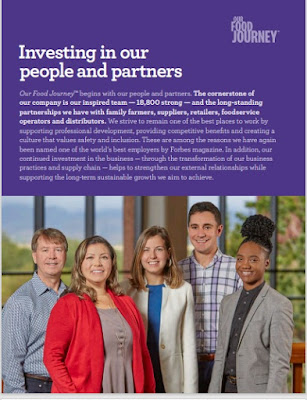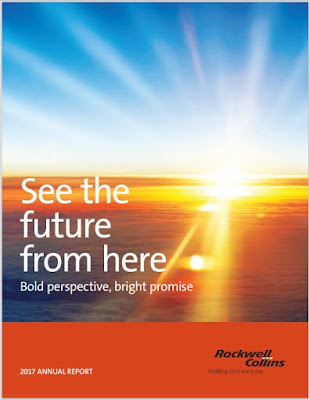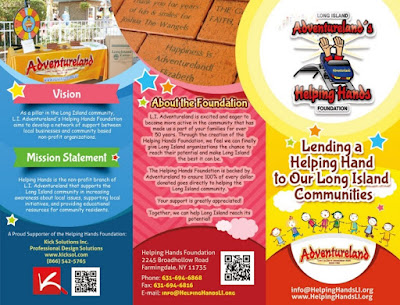Planning Media Kits, Writing Reports
Read for October 21, 2024: Public Relations writing involves several levels of corporate writing, and reports are an important part of corporate writing. The annual report, for a publicly traded corporation or a nonprofit, is not only a legally required statement of financial data, but often a key PR and marketing tool, too.
I’ll write about that in the second half of this post. I am not assigning a lab assignment based on chapter 1 of your style guide--we won't try to write a report--instead, the writing this week be be based on chapter 6 in your text on Media Kits. That's what I'll write about first here (but although I don't assign chapter 1 for lab writing, note that this blog post does cover reports and there will be some quiz questions about them).
First: The kit—another PR artifact that is like the report in that it combines lots of items and takes some coordination and planning.
Media Kits
A “media kit” (or press kit, the names are interchangeable) simply refers to a related collection of PR documents that are presented together to achieve a PR strategic communication goal. Your text describes the “shell,” which is a physical folder or holder for when the kits are in printed form. If your organization has a big, important event such as the opening of a new headquarters building, and you invite media to the event, you probably would prepare folders of information for attending broadcast and print reporters.
Those folders are the media kits. Although it’s not the most important aspect of the kit, sometimes the shell can be something creative—I recall as a newspaper editor back in the 1980s getting the media kit from VW when they were re-launching the Beetle, and the kit came in a small beetle-shaped box.
Cute—but costly. Most kits are more mundane and in more practical shells. Standard two-pocket folders are typically used—but use attractive folders that will have your colors or logo on the cover.
Besides the physical kits, a set of related PR documents is more often packaged on the web. The media kit may be presented on the web in several different ways: On a web page for the event or thing, whatever it is, you may have links to relevant documents which comprise the kit. Or, the kit itself may be a discrete PDF document that presents all of the contained printed documents to any interested web user.
To illustrate a media kit, let’s imagine a totally bogus scenario. Taylor Swift has donated $30 million to Saint Gabriel the Archangel College in River City Iowa, with $15 million funding the construction of new music-fine arts building complete with a 5,000-seat auditorium, and $15 million funding an endowment for both fine arts programming and fine arts scholarships.
On a fine day in August 2025, Swift is coming to SGA to present two free concerts—an afternoon one on the Greenspace (which can accommodate up to 15,000 people) and an evening one in the new Swift Performance Theatre. The afternoon concert is free, and while tickets are required to control numbers, they can easily be ordered online. The evening one, also free, is closed to the public, open to donors (besides Swift’s $30 million, the college raised an additional $10 million for the new building) and invited guests.
As a PR writer for Saint Gabriel, you correctly assume that regional and possibly national media may be attracted to this event. Heck, some pathetic fan boy, old man professor from MMU in Cedar Rapids might even show up to write a blog post about it and shout “sing ‘You Need to Calm Down’” because that would be the only thing that would calm him down.
As just one point in a larger PR effort surrounding this whole sequence of events, you plan a media kit for the event. What may such a kit contain?
• A main news release, describing the fine arts building and the opening ceremony. It’s basically an “advance” news story giving context.
• A brief bio of Taylor Swift, complete with quotes about why she is donating to SGA.
• Images of the new Swift Fine Arts Center (containing the Swift Performance Theatre). These include the beautiful central lobby with indoor fountain, the stage of the auditorium, an external shot showing the outdoor sculpture garden and external images of the building.
• Publicity images of Swift and of SGA President Dr. Amanda Big Bear.
• The Media Alert for the event (true, if the journalist was here at the event, some may have already received the alert separately, but it’s a convenient event summary that is often included in a kit, and the kit is often sent out in advance with the alert, too).
• A fact sheet listing attributes of the Swift Fine Arts Center—size, seating, special acoustic features of the auditorium, number of classrooms, square footage, special features like the indoor fountain in the lobby or the two art galleries visible from the lobby, etc.
• A backgrounder describing the history of SGA and fine arts programs at SGA.
• A jump drive containing digital versions of all of the above, plus a video interview with Dr. Amanda Big Bear and a video sent in by Taylor Swift in which she talks about the importance of arts education.
The event is a pretty big one, and the kit is thus fairly extensive, but the list above would be typical of such a kit. The college also posts an online version of the kit as a web page on its “News and Events” area of its web site, with digital versions of all of the above. Images are thumbnails on the web site, with links to the college’s flickr stream for full-size images.
Flickr, by the way, is a photo sharing site run by Yahoo! that is often used for sharing PR images. Otherwise, some organizations might use the Google or Microsoft clouds for that purpose.
What a particular media kit includes varies depending on what event or thing is being promoted. In general, it will include at least a news release that describes whatever the main topic is, some sort of fact sheet or white paper that gives more background, and several images. A kit will usually have more than just these three basic artifacts but, again, exactly what the additional materials will be depends on what the kit is for.
Kits are generally available at big events for a journalist to pick up, but are also often mailed in advance, with a cover letter, to describe the big thing, whatever it is. As noted, a kit can either be a literal physical artifact, a web site and/or both. I would say “both” is probably most common in 2024, with an emphasis increasingly shifting to the on-line version.
Media kits are only prepared for big news stories that are likely to be receive media attention—and these days are used for online sources and bloggers, as well as traditional media. (Your text is not wrong to state that the intended audience for kits is journalists, just remember that, in this context, "journalist" may include bloggers or other social media influencers.)
In summary, a kit is not really a document on its own—it’s a coherent collection of related PR artifacts in either a physical folder (shell) and/or web page. The web page option is becoming increasingly popular, with online kits more likely to be interactive pages than simply PDFs of print versions. A media kit (such as the NASA one in the Brightspace samples) can be formatted as a long report, rather than being a collection of discrete documents--but the sections of the NASA report still make it fundamentally a collection of other PR documents.
And for both kits and reports, you can use google to find samples. Be aware that I am accurately describing what a PR media kit is, but the term has a related but different media meaning--what is also called the "editorial calendar," that is, a list of topics being covered by a medium and when they will be covered, is sometimes called a kit. Editorial calendars and such kits are common for some web sites and magazines and are prepared to help advertising sales--such marketing kits are different from the PR kits I describe here.
 |
| Cover of recent University of Iowa annual report. Partly prepared for use with potential donors. |
Annual reports and other reports
A “report” is similar to a kit in that it generally is a collection of related pieces of writing. A typical annual report may include some sort of feature story that covers whatever is the most important topic of the year, a letter which is sort of an op/ed from the organization’s main leader (typically president or CEO or president/CEO), an executive summary of financial data and tables of financial data.
 |
| Inside page (above) from Hormel annual report. And, below, a page of financial charts--many pages of corporate annual reports are used for detailed number reports. |
For publicly traded corporations (corporations that are owned by shareholders where anybody can buy a share), the financial data has to meet legal standards set by the Securities and Exchange Commission, so awareness of SEC rules and adherence to them is vital. Typically, a corporation’s financial people, its accountants and chief financial officers, are thus very involved in this project.
For non-profit entities, there are legally required disclosures to be filed annually, but the annual report is largely a PR document that represents an attempt to be in touch with and thank donors—so besides some financial data, the report typically will have a list of donors, often stratified into ranges (large donors in the “gold circle,” smaller but still substantial donors in the “silver circle,” common people who pitched in a few bucks in the “bronze circle”—those names are arbitrary and vary from organization to organization, as does the financial amount one donates to move from level to level).
Many annual reports thus tend to be fairly slick and elaborate because of their dual purpose to disclose legally required information and to build relationships with key publics. That’s because they reach small, but vital, publics. For a corporation, they are both intended for investors (owners) and for business media covering the company’s industry. For a nonprofit organization, they are intended to be attractive to potential supporters-donors.
 |
| Table of contents of University of Iowa Annual Report. Note that this report is more than 60 pages. It's a huge project. |
At the University of Missouri, where I worked part-time in the PR office of the College of Engineering while I attended graduate school, all of us in the office (four employees) worked for months on an annual report that was 40 pages or so--and that's a modest staff for a fairly modest report.
Done correctly, as your text notes in option chapter 1, an annual report takes months of work. It has to be well planned; all the pieces have to be collected in a timely fashion. It involves getting data from financial people, a communication from the leader, assigned a writer to the feature or features, and having a designer create an attractive cover. The opening narrative and executive letter are often designed like slick magazine stories.
Many annual reports include multiple images, too, so a photographer and graphic artist are often part of the annual report team.
An annual report, like a media kit, can either be a physical document, web page or both. As with any kind of PR writing, when you’re working on your first one, take the time to carefully and thoroughly read the latest five reports at your organization to orient yourself to the project, and then use Google to find other samples from other organizations, particularly ones that are similar to yours.
In a few minutes, I was able to quickly find these, for example, plus all of the PDF samples that have posted for you on Brightspace:
Girls Who Code 2017 annual report (web site report):
https://girlswhocode.com/2017report/
Sierra Club 2017 annual report (PDF online of print report):
https://www.sierraclubfoundation.org/sites/sierraclubfoundation.org/files/2017_annualreport.pdf
Habitat for Humanity online 2018 annual report:
https://www.habitat.org/multimedia/annual-report-2018/
Other reports
A publicly-traded corporation will have to release quarterly earnings statements, in addition to the annual report. Typically, these are nowhere near as elaborate, generally consisting of a news release and a table of financial data.
But PR writers will often get involved in other “reports” that may be less than annual. For example, if you work for a nonprofit that has a large funding campaign—to grow an endowment or build a facility, for instance—that campaign may include some initial materials and some follow-up that could be in the form of a substantial report (generally to donors and board members, but it could be public, too).
Universities often undergo review processes that are less than annual. These generate substantial reports.
Every few years, for example, the state of Iowa will review teacher education sites, and any college granting teaching degrees in Iowa will have to report to the state every few years.
Buena Vista University in Storm Lake, in 2001, had seven different community colleges where there where teacher education programs run by BVU. They had to prepare a 30- to 40-page report for each of those seven sites—and the education faculty at BVU could not complete all of those reports, particularly because a lot of the work had to happen that summer. So, they hired a project writer (me). I was between previous employment as a business journalist and starting my faculty position at MMU that summer.
Such corporate incidental reports are not strictly PR documents—the BVU education reports certainly were not—but they are key kinds of corporate communication, and any professional writer should be able to understand and complete such a project. Mainly what I had to do that summer was speak with the head of the education department, quickly read the very wordy state guidelines to determine what was needed in the official report, and, with the ed department head’s help, coordinate getting the necessary information from the directors at each of the seven sites.
Then, I got to write seven 30- to 40-page reports. They could not be the same, so it was not “cut and paste,” but the reports followed the same structure and covered much of the same ground, so it was also not starting from scratch seven times.
The point of the BVU story is that any corporate report, either for PR purpose or other purposes, involves your ability to understand complex goals, follow any important guidelines, extract information from sources (and get their cooperation to provide data in a timely manner) and work with a team of other employees.
Although an annual report often includes something that is akin to a feature story, in general the writing in corporate reports is more direct. It has to be clear, concise and accurate. It needs to address the needs both of who is communicating, but most of all meet the needs of the public that is consuming the data.
Reports typically aren’t for your largest publics—although an annual report is often a public document. But the consumers of reports are usually key publics, and you have to do grammatically perfect, accurate and clear writing to achieve any corporate report’s goals.




Comments
Post a Comment